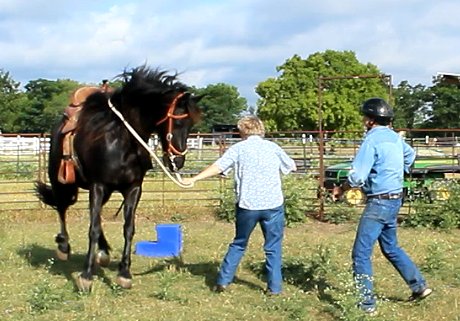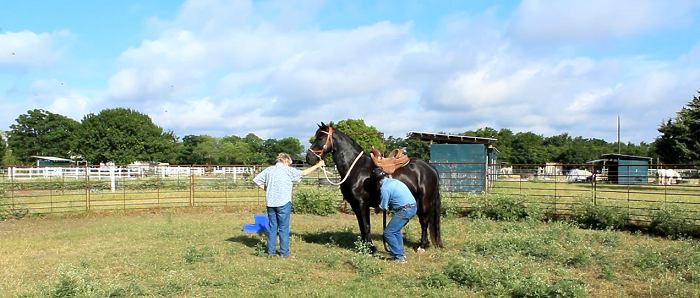“Cinchy” horses object in one way or another to having the saddle-cinch tightened. It can be as mild as just turning to threaten to bite or as dramatic as throwing their body backward onto their back or bucking on top of you. It can be very dangerous. While reading this assessment and possible solutions, take pains to stay safe: out of kicking and biting range, away from the rear-throwing area, out of the forward path of a bucking horse.
 I am currently in the process of ferreting out a reason for a green horse that I am training to become cinchy all of a sudden when he has been saddled and even ridden previously many times without incident. He unexpectedly started mild (but scary) bucking during the cinching procedure and continued sporadic bucking during his previously smooth and beautiful lunging exercises.
I am currently in the process of ferreting out a reason for a green horse that I am training to become cinchy all of a sudden when he has been saddled and even ridden previously many times without incident. He unexpectedly started mild (but scary) bucking during the cinching procedure and continued sporadic bucking during his previously smooth and beautiful lunging exercises.
He is a very gentle and willing horse, so this behavior is uncharacteristic to say the least.
I have movies of the first incident and have come to a possible theory after examining them. But there are many reasons for a horse to become overly-sensitive to the saddling experience, and here are some ways to narrow them down.
1. Pain in the back or girth area
2. Panic or claustrophobia caused by improper introduction of the equipment
3. Previous poor handling that has imprinted a painful or frightening anticipation when the equipment is mounted and tightened.
4. Over-cinching or tight cinching without warning or warm up
Each of the reasons should be ruled out.
1. Pain in the back or girth area If this is a seasoned horse who has just started this behavior, the first order of investigation is to be sure there is no problem with the equipment. No burrs, points, nor imperfections in the equipment that are gauging or poking him. (Hope that that is the only problem – something easy to cure instantly).
Going deeper, body pain will often present when you do some massaging and prodding into areas that might be sore – either from injury, fatigue, or poorly fitted equipment. Using the tips of your fingers, start pressing into his back on either side of the spine from his withers to his rump. Also press and rub into the girth area just behind his elbow. There is a large, important muscle there that is adversely affected by tightening and over-tightening a cinch. It can be painfully struck and affects his ability to breathe and move fluidly.
If he tolerates gentle rubbing in those areas but objects to deeper pressure, take notice. If you see him flinching, moving away, or other more dramatic behavior such as turning to nip, have it checked by a veterinarian or qualified massage therapist.
There is much more to finding pain, so if you suspect there is any, be sure to check with a professional – especially of your horse has been fine on previous occasions and is now showing a cinching problem.
2. Panic or claustrophobia caused by improper introduction of the equipment If this is a green horse, the easiest solution for this problem is to go back to the beginning of Saddle De-Sensitizing. Spend as long as it takes to see him relax in the presence of and mounting of the saddle.
Work on de-sensitizing in general. It is critical to his acceptance of new objects or procedures.
Work on tying. It introduces restraining and restriction in the general sense (he should not be tied during tacking)
Work on slow and gentle introduction to each piece of equipment and each procedure associated with it. Using a lead rope or surcingle, simulate the girthing procedure until it is smooth and easy before you move on to actual girthing with the saddle. see: First Saddle Experience
3. Previous poor handling that has imprinted a painful or frightening anticipation when the equipment is mounted and tightened. Horses don’t forget. If he has been previously over-tightened, handled roughly or in any other way been frightened during the cinching process, that impression can be very hard to overcome. It takes a lot of time, patience, and repeated good experiences to end the problem.
However, it is a go-to excuse in many instances where an owner cannot find another reason easily. It is the classic “my horse was abused” excuse that gives rise to a reason to continue the bad behavior rather than do the hard work of curing it. See Abused Horses
4. Over-cinching or tight cinching without warning or touch-warm up. This is probably the most common problem – especially when a rider is tacking and doing other things at the same time or is in a hurry. It also happens when a horse is being saddled by a novice or insecure rider or when tacking for a heavier rider or a very round horse. Tacking should be a conscious and polite procedure. It involves (first) touching/rubbing the horse in the saddle area before it is mounted on his back, then (second), when the pad and saddle are mounted, running your hand under the chest with positive-touch so that he feels you reaching under to catch the girth. This is a polite way to give him a little warning.
When a horse is caught off guard by a fast, jerk-tighten experience, his tendency is to throw back toward his haunches and hold his breath. Holding his breath causes the cinch to become even tighter and him to become even more frightened. (Kicking a horse in the gut does NOT release their breath nor teach them not to throw back. I had the unpleasant experience of having a woman kick my horse in the stomach when she threw back. The woman thought is was a show of “professional horsemanship”. It made me livid.)
Shocking your horse by tightening quickly and overly tight can certainly cause a panic attack that results in a train wreck.
There are slow and steady steps to the cinching procedure. When the girth is first tightened, it should be tightened a little bit, slowly and gently, not jerked into position. Then a nice walk around to allow him to breath and get comfortable, then another notch or two, another walk and relaxation minute, then a final tightening.
If you cannot get your hand comfortably between the cinch and his body behind the elbow it is probably too tight. The long muscle that resides there carries a lot of weight, including his ribs, his organs and the rider. It is easily bruised or overly-restricted. A well-fitted saddle needs less tightening than a poorly-fitted saddle. A horse with a good withers bone needs less pressure at the cinch area to hold the saddle in place. Mutton-withered horses have almost nonexistent withers and are hard to saddle loosely as the saddle has no way to stay upright on his back.
Will your horse tie easily? Has he been taught to tie or cross tie before saddling is attempted? While a horse should be saddled without tying, it is important that he understand restriction and restraint and “giving to pressure” in a general sense before saddling.
Saddling should be done untied with as little restraint as possible.
Tying a horse down or restricting his movement can be dangerous for him and you. It can add a second layer of pure panic. If he lunges backward, he can actually damage his sensitive head/neck area when he meets the abrupt end of the tie. If he throws himself down or over backward, YOU can get caught in the line of fire as he thrashes or he can damage his back.
Tying adds worse than just insult to injury. Panic starts when he is surprised and frightened by something tight around his chest, restricting his breathing and movement. Then he finds he is tied and can’t get away. His worst fear is realized: he is being trussed like a pig for the slaughter.
If you are tying your horse because it is the only way to control him for the saddle, then he is not ready for the saddle. And one or both of you could get hurt. Go back to ground work.
Some tips and considerations
Horses are rarely “naughty” or willful when defined as “cinchy”. More often than not it is caused by fear. For this reason, a horse should never be punished for the behavior. I have been guilty, myself, of mis-interpreting a horse’s reaction as “testing me” to see if he could get out of work, and giving several severe halter jerks to stop the panic. That was me being the “dummy” that this blog is supposed to help.
In a panic attack, a horse cannot hear a verbal command nor reason his way out of the behavior. It is best to stay out of the way but loosen the offending equipment as quickly as SAFETY permits. Then start at the beginning again.
Most horses will be more accommodating if worked on some very easy, basic ground work before saddling: things like walking calmly, flexing, and backing up. It sets their frame of mind into a “cooperative” and “reasoning” mode.
If you can mount a camera to the fence or have a partner film the cinching procedure, it is sometimes really helpful to see the problem or even see it in slow motion. A horse’s reaction time is so quick, and this problem can be so dramatic, the handler rarely sees the details or the exact moment of reaction.
If this is a brand new problem, check the equipment for flaws first and then suspect over-cinching, cinching too quickly, and cinching too tight. It’s an easy mistake to make but can have dire consequences.
My conclusion for the unexpectedly cinchy trainee: The horse was being saddled by a new handler who had never saddled this particular horse before. The movie shows a horse who is slightly “antsy” as the new handler saddles from the off side. Then very quick and “jerky” cinch procedure by a handler who routinely cinches a horse very quickly and very tight. Although asked to cinch less than “riding tight”, I suspect that the job was too fast, too unthinking, and too tight for this green horse.
The next steps will be to repeat a polite saddling technique ad nauseum to extinguish his anticipation of a bad experience that might linger from this one experience.
Under no circumstances should information presented here be construed as veterinary in nature. Always consult your veterinarian if problems persist. Additionally, horse training and equestrian activities in general can be dangerous. While we try to present relevant and valuable content, under no circumstances does horse-pros.com or its members or contributors take any responsibility for the well-being of any horse or person using a method outlined here.
We certainly don’t know everything. Please share your expertise. Comment on what is already written or Suggest a Category and Educate us about it. Grow Horse-Pros.com©

Please stop abusing your horses! You need to review all your training methods. You are not thinking like a horse and until you do you will continue to have problems. Please see Rick Gore’s review on your training.
Hi Cheryl: Thank you for taking the time to write. I will invetigate some of Rick Gore’s training. There are many excellent trainers out there that deserve respect. And the art of training is becoming more sophisticated and even scientific every day. See Warwick Schiller’s youtube channel for some amazing new methods.